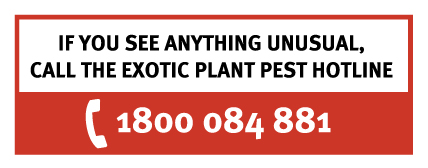


The larger grain borer (sometimes called greater grain borer) (Prostephanus truncatus, Horn) is a tiny exotic beetle that causes significant damage to stored maize (corn) and cassava tubers overseas. The insect also invades wheat, triticale and sorghum.
It copes with very dry conditions better than many other stored grain pests so it poses a considerable threat to stored grain in Australia. In addition to causing losses to harvested produce, restrictions would be placed on shipments of grain from Australia if the beetle established here.
Larger grain borer adults are around 3.5 to 5.5 mm long with dark brown colouring. The adult insect body is cylindrical shaped and has a pitted surface, with a blunt squared off end. The head is tucked under the thorax so it cannot be seen from above.
Larvae are fleshy, thick and white with a curved ‘C’ shape. The larvae also have a sparse covering of short hairs.
Adults could be confused with other stored grain pests such as the common lesser grain borer (Rhizopertha dominica) although the lesser grain borer is much smaller. Under magnification the lesser grain borer can be seen to have a narrower body shape that is more rounded at the end. Larger grain borer could also be confused with Sitophilus weevils, which are found in grain and maize.
Larger grain borer is known to attack maize in the field right before harvest as well as feeding in stores of grain. Look for ‘dust’ produced by the adult beetles when they bore into the grain. It is also known to bore into a wide range of non-grain commodities including bamboo, wood and even plastic.
Larvae and pupae of the beetle can be found in the excavated tunnels in produce.
The insect spreads mostly through movement of infested grain, but can also fly over short distances as an adult.
The larger grain borer is known to occur in the US and parts of Canada, Central and South America, Europe, Africa and North, South and South-East Asia.
Keep a look out for this exotic pest threat by making frequent inspections of your crop and stored grain or other commodities. Make sure you are familiar with common pests so you can tell if you have found something different.
If you see anything unusual, call the Exotic Plant Pest Hotline on 1800 084 881.

The larger grain borer (sometimes called greater grain borer) (Prostephanus truncatus, Horn) is a tiny exotic beetle that causes significant damage to stored maize (corn) and cassava tubers overseas. The insect also invades wheat, triticale and sorghum.
It copes with very dry conditions better than many other stored grain pests so it poses a considerable threat to stored grain in Australia. In addition to causing losses to harvested produce, restrictions would be placed on shipments of grain from Australia if the beetle established here.
Larger grain borer adults are around 3.5 to 5.5 mm long with dark brown colouring. The adult insect body is cylindrical shaped and has a pitted surface, with a blunt squared off end. The head is tucked under the thorax so it cannot be seen from above.
Larvae are fleshy, thick and white with a curved ‘C’ shape. The larvae also have a sparse covering of short hairs.
Adults could be confused with other stored grain pests such as the common lesser grain borer (Rhizopertha dominica) although the lesser grain borer is much smaller. Under magnification the lesser grain borer can be seen to have a narrower body shape that is more rounded at the end. Larger grain borer could also be confused with Sitophilus weevils, which are found in grain and maize.
Larger grain borer is known to attack maize in the field right before harvest as well as feeding in stores of grain. Look for ‘dust’ produced by the adult beetles when they bore into the grain. It is also known to bore into a wide range of non-grain commodities including bamboo, wood and even plastic.
Larvae and pupae of the beetle can be found in the excavated tunnels in produce.
The insect spreads mostly through movement of infested grain, but can also fly over short distances as an adult.
The larger grain borer is known to occur in the US and parts of Canada, Central and South America, Europe, Africa and North, South and South-East Asia.

Keep a look out for this exotic pest threat by making frequent inspections of your crop and stored grain or other commodities. Make sure you are familiar with common pests so you can tell if you have found something different.
If you see anything unusual, call the Exotic Plant Pest Hotline on 1800 084 881.